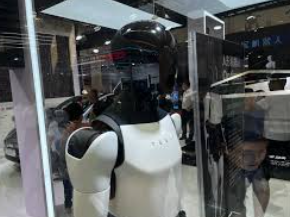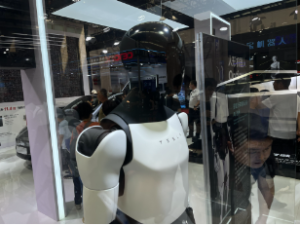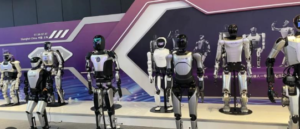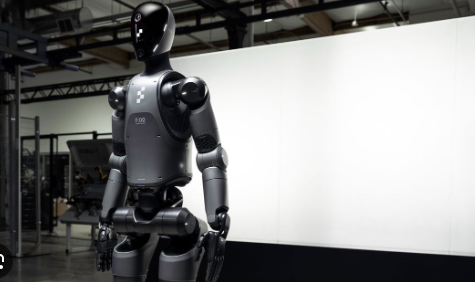Tesla’s humanoid robot, Optimus, encountered stiff competition at the World Robot Conference (WRC) in Beijing, showcasing the rapid advancements in humanoid robotics from around the world. Held from August 22, 2024, the conference highlighted a record 27 new humanoid robots, underscoring the growing interest and investment in this technology.
While Tesla displayed its Optimus inside a clear box next to its vehicles, the event featured a diverse range of humanoid robots from Chinese companies. These robots demonstrated various capabilities, from playing traditional instruments like the zither to performing tasks such as grabbing sodas and executing intricate Chinese martial arts.
Key Highlights from the World Robot Conference
The WRC showcased significant progress in humanoid robotics, with notable presentations from startups such as Agibot and Stardust Intelligence. Agibot, a Shanghai-based company, unveiled five new robots designed for roles including sales assistance and factory work, with deliveries expected to begin in mid-October. Stardust Intelligence’s Astribot S1 impressed attendees with its ability to fold shirts and pour wine.
China’s investment in robotics has surpassed 100 billion yuan ($14.01 billion) over the past decade, reflecting a robust push towards advancing humanoid technologies. Wei Cao of Lanchi Ventures projects that the next milestone will be the development of commercially viable humanoids capable of performing complex manufacturing tasks.
Tesla’s Position in the Humanoid Robotics Race
Despite the impressive advancements by Chinese companies, Cao notes that U.S. firms, including Tesla, are currently ahead in humanoid robotics technology. Tesla’s Optimus, while showcased in a static display, is expected to be tested in its factories next year. Elon Musk has claimed that Optimus will eventually be able to perform household tasks like folding laundry and cooking, potentially adding substantial value to Tesla.
Challenges and Future Outlook
The conference also addressed ongoing challenges in humanoid robotics, such as limited battery life and the need for advanced emotional expression. Industry experts, including Shigeki Sugano of the Robotics Society of Japan, predict that fully autonomous humanoid robots may not be feasible until after 2050.
As the field continues to evolve, the competition between international players like Tesla and emerging Chinese startups highlights the dynamic nature of humanoid robotics development. The advancements showcased at the WRC signal a promising future for these technologies in both commercial and industrial applications.
Tesla’s Optimus humanoid robot met significant competition at the World Robot Conference (WRC) held in Beijing from August 22, 2024. The conference set a new record with 27 humanoid robots showcased, reflecting a growing surge in humanoid robotics innovation and investment.

Chinese Companies Showcase Advanced Humanoids
Chinese companies displayed an impressive array of humanoid robots, each demonstrating diverse capabilities:
- Agibot, a Shanghai-based startup, unveiled five new humanoid robots, with some available for preorder with a deposit of 5,000 yuan ($700). These robots are designed for roles such as sales assistance and factory tasks. The company plans to start deliveries in mid-October, followed by an initial batch of 300 units in November.
- Stardust Intelligence introduced its Astribot S1, a humanoid robot capable of performing complex tasks including folding shirts and pouring wine. The company, founded in December 2022, uses advanced AI for imitation learning, enabling its robots to replicate actions by observing them.
Other notable robots at the conference included those from Galbot and Turui, which demonstrated abilities such as placing items into baskets and transporting soda cans.
Investment Surge and Technological Milestones
China’s robotics sector has seen over 100 billion yuan ($14.01 billion) in investment over the past decade. Wei Cao of Lanchi Ventures highlighted that the next major milestone in humanoid robotics will be the development of robots capable of performing complex manufacturing tasks. Cao anticipates that humanoids will soon need to handle multiple tasks simultaneously and prioritize effectively in a commercial setting.
Tesla’s Approach and Industry Position
Tesla showcased Optimus in a static display next to its vehicles, a move that contrasts with the dynamic demonstrations by Chinese competitors. Elon Musk has stated that Optimus will eventually be able to handle tasks such as folding laundry, cooking, and cleaning, contributing to Tesla’s projected $25 trillion valuation. Tesla plans to begin testing Optimus in its factories next year.
Jeff Burnstein, president of the U.S. Association for Advancing Automation (A3), noted in a recorded video presentation at the conference that while many humanoid robots are in pilot programs, some have already transitioned to more extensive use. A humanoid robotics conference will be held by A3 in Tennessee on October 7.

Technological Challenges and Future Outlook
The conference also addressed several key challenges in humanoid robotics:
- Battery Life: Current humanoid robots typically require recharging every two hours, posing a significant hurdle for continuous operation.
- Emotional Expression: Full autonomy, including the ability to express emotions, remains a distant goal, with experts like Shigeki Sugano predicting that fully autonomous humanoids may not be realized until after 2050.
Comparative Insights
According to Cao, while U.S. technologies, including those from Tesla, are currently one to two years ahead of Chinese developments, China has achieved self-sufficiency in over 95% of the humanoid robotics supply chain. This self-reliance is expected to drive further innovation and reduce dependency on foreign technologies.






